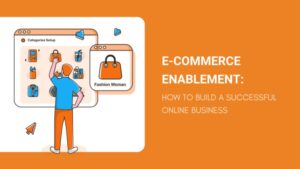How to E-Commerce Enablement
E-commerce enablement is a crucial component of online business success. It involves a comprehensive process that includes various tools and strategies for online business growth and customer engagement. It includes everything from user-friendly web design to efficient shipping processes.
This enables businesses to reach a global audience and boosts efficiency and competitiveness. It also allows businesses to better understand their customers’ needs and preferences.
E-commerce enablement involves the process of integrating and optimizing digital technologies to support and enhance online business activities. Whether you are starting a new e-commerce venture or looking to upgrade an existing business, here are the key steps to enable e-commerce.

- Business Strategy:
- Define your e-commerce goals and objectives.
- Identify your target audience and market.
- Choose the right products or services to sell online.
- E-commerce Platform:
- Select a suitable e-commerce platform that aligns with your business needs. Popular options include Shopify, WooCommerce (WordPress), Magento, BigCommerce, and others.
- Consider factors such as ease of use, scalability, features, and cost.
- Domain Name and Hosting:
- Choose a memorable and relevant domain name for your online store.
- Select a reliable hosting provider to ensure your website’s performance and security.
- Website Design:
- Design a user-friendly and visually appealing website. Consider responsive design to ensure compatibility across various devices.
- Optimize the website for easy navigation and a seamless shopping experience.
- Product Catalog:
- Organize and showcase your products or services clearly.
- Include high-quality images, detailed product descriptions, and pricing information.
- Payment Gateway:
- Set up a secure and efficient payment gateway to facilitate online transactions.
- Offer multiple payment options to cater to a broader audience.
- Security Measures:
- Implement SSL certificates to secure customer data and transactions.
- Regularly update and patch your website to protect against vulnerabilities.
- Order and Inventory Management:
- Implement a robust order processing system to efficiently manage and fulfill customer orders.
- Keep accurate track of inventory levels to prevent overselling.
- Shipping and Logistics:
- Choose reliable shipping partners and set up a transparent shipping policy.
- Provide tracking information to customers and offer shipping options.
- Customer Support:
- Implement a responsive customer support system through various channels (email, live chat, phone).
- Address customer queries and concerns promptly.
- Marketing and Promotion:
- Develop a digital marketing strategy to drive traffic to your e-commerce site.
- Use social media, search engine optimization (SEO), and other channels to promote your products.
- Analytics and Insights:
- Integrate analytics tools to track website performance and user behavior.
- Use data insights to make informed decisions and optimize your e-commerce strategy.
- Legal and Compliance:
- Ensure compliance with local and international e-commerce regulations.
- Clearly communicate terms and conditions, privacy policies, and refund/exchange policies.
- Mobile Optimization:
- Optimize your website for mobile users, as a significant portion of online traffic comes from mobile devices.
- Continuous Improvement:
- Regularly evaluate and update your e-commerce strategy based on customer feedback, market trends, and technological advancements.
By following these steps, you can effectively enable e-commerce for your business and create a successful online presence.
Platforms
A strong e-commerce enablement strategy is essential for businesses looking to thrive in the digital world. These strategies can help businesses connect with new audiences and grow their revenue. They can also offer convenience and worldwide reach, which are important factors for attracting today’s tech-savvy consumers.
Whether you are a retail business that operates through brick-and-mortar stores or a service-based company, e-commerce can help you increase your reach and boost your revenue. It can also make your company more efficient by reducing shipping costs and processing times. Moreover, a solid e-commerce platform can also help you create a personalized customer experience and improve your customer’s overall shopping experience.
E-Commerce Enablement platforms allow you to manage your entire online business from one central location. They can integrate with your payment gateways, track inventory, and manage sales campaigns. They can also provide data analytics that can help you identify the best products for your market. In addition, they can handle all the security and regulatory requirements of your business.
In addition, a robust e-commerce platform can help you avoid pitfalls such as a clunky checkout experience and confusing product listings. By monitoring the entire buying process, you can identify the areas that are hindering your customers’ experiences and make necessary changes in real time. With the right e-commerce platform, you can also reduce cart abandonment rates and increase your revenue.
Payment gateways
Payment gateways are a vital part of e-commerce enablement. They help customers browse and buy products from your online store, enter their credit card details, and securely submit them for verification. They also make it possible for recurring subscription services to collect payments automatically. This simplifies your collections process, puts more money in your account sooner, and makes it easier for your customers to manage their accounts.
A payment gateway is a virtual version of a point-of-sale terminal chip reader that connects to a website and processes a customer’s credit card information during an online transaction. It encrypts this information to keep it private and sends it to the customer’s bank to verify that there are sufficient funds in their account. Then, it transfers these funds to the merchant’s bank (known as the acquiring bank) to complete the transaction.
This is all done behind the scenes, but it allows businesses to offer a more convenient shopping experience for their customers. It also helps reduce cart abandonment and sales conversion rates by providing customers with a variety of options for payment. This flexibility can also make it easier to accommodate customers with specific preferences and needs, which boosts customer satisfaction and sales.
Shipping options
Shipping options are a critical part of any ecommerce business. They help you maximize sales and meet customer expectations. You can offer free shipping, expedited delivery, or a mix of both. However, you need to choose the right option for your customers’ needs and budgets.
When choosing an ecommerce shipping method, consider the product size and weight as well as the packaging requirements. You should also factor in the delivery destination, which will impact cost efficiency and customer satisfaction. For example, next-day or two-day shipping may be more expensive than standard delivery, but it will improve the customer experience.
Another important consideration is the time of year. For instance, during the holiday season, shoppers want to receive their purchases quickly. If they don’t see fast and affordable shipping options, they might abandon the cart. To avoid this, you should provide an estimated shipping date on your checkout page and product pages.
You can also add a feature that allows your customers to ship items to multiple addresses in one order. This is especially helpful during the holidays when customers want to send gifts to family and friends. In addition, you can enable a “porch pirate” option that lets shoppers choose to leave their packages by the door for pickup instead of having them delivered. This can help you reduce theft and ensure that your customers’ deliveries arrive promptly.
Customer service
Ecommerce enablement is a vital part of any online business. It provides businesses with the tools and strategies they need to increase sales and compete effectively. It encompasses a variety of aspects, including design and layout, payment processing, shipping options, and customer support. To be successful, an ecommerce store must have all of these components working together seamlessly. In addition to providing a seamless shopping experience for customers, ecommerce enablement also allows businesses to identify and correct any problems that may be impeding their growth.
Another important aspect of ecommerce enablement is ensuring that your website has tight security during payments. This is essential to prevent hackers from stealing sensitive data or financial information. It also helps you to keep your website up and running, even during peak times.
Ecommerce fulfillment is often overlooked, but it is crucial to the success of your business. It is often the last step in a client’s journey, so it needs to be as smooth and seamless as possible. In order to do so, companies rely on a variety of different software and technology solutions. These tools and technologies are known as eCommerce enablers, and they must all work together seamlessly to deliver an outstanding customer experience. One of the best ways to ensure this is by partnering with a 3PL fulfillment company like WareIQ.

Leave a Reply